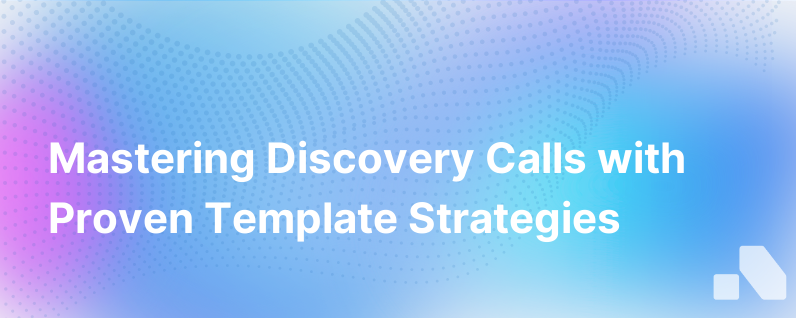Discovery Call Template
Published on December 26, 2023 by Sawyer Middeleer
The art of making a sale often begins with a single, critical interaction: the discovery call. This is the moment where a potential customer's needs and a company's offerings start to find common ground, and where the foundation for a fruitful relationship is laid. Having a structured template for discovery calls is akin to having a roadmap for finding treasure; it's the guide that leads to the jewels of customer insights and sales opportunities.
Here we’ll provide a high-level template, enhancing with tips and best practices to make your discovery calls as effective as possible.
Discovery Call Template Overview
1. Introduction and Rapport Building: (5 minutes)
- Brief welcome: Begin with a friendly greeting to set a positive tone.
- Personal rapport: Find a personal connection or comment on something topical to warm up the conversation.
- Agenda overview: Provide a brief run-through of what the call will cover.
"Hello [Name], it’s great to connect with you. How has your day been? I noticed [personal note or recent company achievement], congratulations on that.
I’d like to take the next [length of call] to understand your business needs, explore how we might help, and see if there’s a good fit. How does that sound?"
2. Understanding the Prospect's Business: (10 minutes)
- Company Overview: Invite the prospect to describe their business and role.
- Current initiatives and goals: Ask about overall business objectives, short-term and long-term.
"Could you tell me more about your company and your role? What are some of the key initiatives you’re focused on right now?"
3. Exploring Challenges: (15 minutes)
- Identify pain points: Open-ended questions to uncover challenges.
- Impact of challenges: Probe into how these issues affect their business.
"What are some of the biggest challenges you’re facing in reaching your current goals? How are these challenges impacting your operations or team?"
4. Discussing Solutions: (10 minutes)
- Current solutions: Inquire about current tools or processes.
- Satisfaction and shortcomings: Understand their satisfaction with current solutions.
"What solutions or strategies have you employed to address these challenges? How well are they working for you?"
5. Value Proposition: (5 minutes)
- High-level solution mapping: Based on the information, sketch how your product could potentially help.
- Tailored benefits: Highlight benefits that specifically address discussed challenges.
"Given what you’ve shared, it sounds like our solution could help [specific solution to a challenge]. Our customers often find that [specific benefit] is particularly valuable. Does that resonate with your situation?"
6. Next Steps: (5 minutes)
- Confirmation of interest: Gauge their reaction to your proposed value.
- Outline next steps: Suggest a follow-up with more detailed information, a demo, or an introduction to a specialist.
- Open to questions: Encourage the prospect to ask any immediate questions.
"How does what we’ve discussed sound to you? I believe a deeper dive into our platform could be beneficial. I can set up a follow-up meeting where we can provide a detailed demo. Would that be of interest?"
7. Additional Insights: (Adjust time as needed)
- Flesh out details: If time and interest allow, dive deeper into any valuable topics that have emerged.
- Understanding the decision-making process: Learn about their timeline and procurement process.
"If you don’t mind sharing, could you tell me a bit about how decision-making works regarding new solutions within your company?"
8. Wrap Up: (5 minutes)
- Recap the conversation: Summarize key points and agreed next steps.
- Express gratitude: Thank the prospect for their time and insights.
- Firm up next meeting: Secure a date and time for the next conversation.
"To recap, we'll [brief summary of next steps]. Thanks for the insightful conversation today, [Name]. Let’s aim to reconvene on [proposed date/time]. Does that work for you?"
Best Practices for Discovery Calls
Now let’s enhance this template with some effective practices that will elevate your discovery calls.
Tailor Your Approach
While the template provides a general structure, tailor your questions and focus areas to the prospect’s industry, role, and known challenges. Preparation is critical. Research the prospect’s company and any recent news that could be relevant.
Actively Listen and Adapt
The best salespeople master the art of active listening. Refine your ability to hear and respond to what your prospects really say (and mean), following up on statements that uncover deeper insights.
Keep Control, But Don’t Dominate
Discovery calls should be conversations, not interrogations or monologues. It’s a dance of give-and-take; while you should steer the conversation, ensure there’s ample space for the prospect to share their thoughts.
Be Genuinely Curious
Genuine curiosity fosters stronger connections and uncovers more valuable information. Your goal is to understand the prospect’s needs thoroughly, not just to pitch your product. This sincerity often translates into trust and a richer discussion.
Use CRM Tools Effectively
Leverage your CRM to track and analyze your discovery calls. Capture insights that can inform personalized follow-ups and nurture campaigns, ultimately tailoring the sales approach more precisely over time.
Refine with Experience
After each call, take time to reflect on what worked and what didn’t. Use these insights to continuously refine your discovery call template and approach.
Conclusion
Discovery calls are an indispensable part of the B2B sales process, providing a critical opportunity for sales teams to gain insights and build rapport with potential customers. By following a well-crafted template, you can ensure that every discovery call is both productive and structured, laying the groundwork for a strong sales pipeline.
With Aomni’s AI platform, B2B sales reps have access to real-time account research and sales content that can make the discovery call process even more effective. By utilizing AI to understand the customer's needs and market dynamics quickly, sales reps can approach each discovery call with greater confidence and personalization, ultimately leading to more successful outcomes.